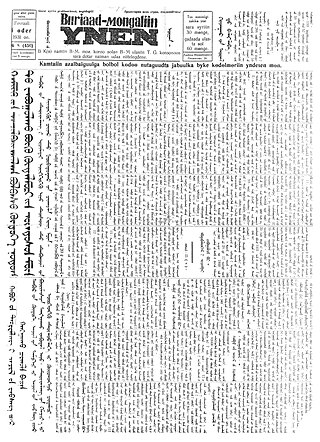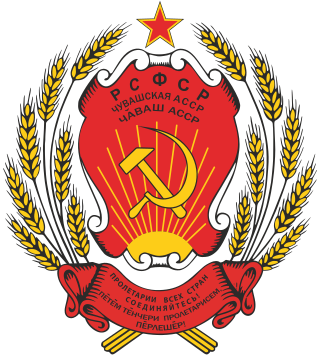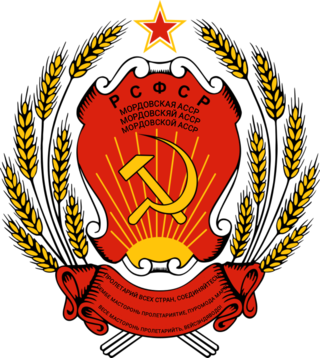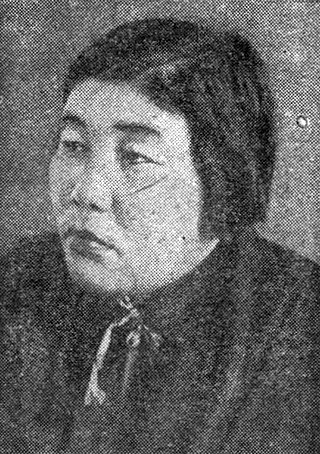
The Buryats are a Mongolic ethnic group native to southeastern Siberia who speak the Buryat language. They are one of the two largest indigenous groups in Siberia, the other being the Yakuts. The majority of the Buryats today live in their titular homeland, the Republic of Buryatia, a federal subject of Russia which sprawls along the southern coast and partially straddles Lake Baikal. Smaller groups of Buryats also inhabit Ust-Orda Buryat Okrug and the Agin-Buryat Okrug which are to the west and east of Buryatia respectively as well as northeastern Mongolia and Inner Mongolia, China. They traditionally formed the major northern subgroup of the Mongols.

An Autonomous Soviet Socialist Republic was a type of administrative unit in the Soviet Union (USSR), created for certain ethnic groups to be the titular nations of. The ASSRs had a status lower than the constituent union republics of the USSR, but higher than the autonomous oblasts and the autonomous okrugs.

The Tatar Autonomous Soviet Socialist Republic, abbreviated as Tatar ASSR or TASSR (1920–1990), was an autonomous republic of the Russian SFSR. The resolution for its creation was signed on 27 May 1920 and the republic was proclaimed on 25 June 1920. Kazan served as its capital.

Buryatia, officially the Republic of Buryatia, is a republic of Russia located in the Russian Far East. Formerly part of the Siberian Federal District, it has been administered as part of the Far Eastern Federal District since 2018. It borders Irkutsk Oblast and Lake Baikal, the deepest lake in the world to the north, Zabaykalsky Krai to the east, Tuva to the west and Mongolia to the south. Its capital is the city of Ulan-Ude. It has an area of 351,300 square kilometers (135,600 sq mi) with a population of 978,588. It is home to the indigenous Buryats.

Buryat or Buriat, known in foreign sources as the Bargu-Buryat dialect of Mongolian, and in pre-1956 Soviet sources as Buryat-Mongolian, is a variety of the Mongolic languages spoken by the Buryats and Bargas that is classified either as a language or major dialect group of Mongolian.

When the Soviet Union existed, different governments had ruled the southern Caucasus regions of Chechnya and Ingushetia. Within the Mountain Autonomous Socialist Soviet Republic, later annexed into the Russian Socialist Federative Soviet Republic, they were known as the Chechen Autonomous Oblast and the Ingush Autonomous Oblast, which were unified on January 15, 1934, to form the Checheno-Ingush Autonomous Oblast. It was elevated to an autonomous republic as the Checheno-Ingush Autonomous Soviet Socialist Republic from 1936 to 1944 and again from 1957 to 1993. Its capital was Grozny.

The Komi Autonomous Soviet Socialist Republic, abbreviated as Komi ASSR, was an autonomous republic of the Russian SFSR within the Soviet Union, established in 1936 as successor of Komi-Zyryan Autonomous Oblast.

The Karelian Autonomous Soviet Socialist Republic, Karelian ASSR for short, sometimes referred to as Soviet Karelia or simply Karelia, was an autonomous republic of the Russian SFSR, Soviet Union, with the capital in Petrozavodsk.

The Yakut Autonomous Soviet Socialist Republic, also known as Soviet Sakha, Soviet Yakutia or the Yakut ASSR, was an autonomous republic of the Russian SFSR within the Soviet Union.

The Tuvan Autonomous Soviet Socialist Republic, or the Tuvan ASSR, was an autonomous republic of the Russian SFSR. It was created on 10 October 1961 from the Tuvan Autonomous Oblast. Its territory measured 175,000 square kilometers and bordered Mongolia to the south, Buryat ASSR to the east, Gorno-Altai Autonomous Oblast to the west and Khakas Autonomous Oblast to the north.

The Russian Soviet Federative Socialist Republic, previously known as the Russian Soviet Republic and the Russian Socialist Federative Soviet Republic, and unofficially as Soviet Russia, was an independent federal socialist state from 1917 to 1922, and afterwards the largest and most populous constituent republic of the Soviet Union (USSR) from 1922 to 1991, until becoming a sovereign part of the Soviet Union with priority of Russian laws over Union-level legislation in 1990 and 1991, the last two years of the existence of the USSR. The Russian SFSR was composed of sixteen smaller constituent units of autonomous republics, five autonomous oblasts, ten autonomous okrugs, six krais and forty oblasts. Russians formed the largest ethnic group. The capital of the Russian SFSR and the USSR as a whole was Moscow and the other major urban centers included Leningrad, Stalingrad, Novosibirsk, Sverdlovsk, Gorky and Kuybyshev. It was the first socialist state in the world.

Buryad Unen is the main newspaper in the Buryat language, founded in December 1921 and originally published in the top-down Mongolian script before switching to Latin script in 1931-1938 and eventually Cyrillic script from 1939.

Buddhism in Buryatia, a region in Siberia, Russia, has a deep-rooted history dating back to the 17th century when Tibetan Buddhism first arrived in the area. Initially adopted by ethnic groups like the Selenga and Zede Buryats, Buddhism gradually spread throughout the Transbaikal region. In 1741, it gained formal recognition as an official religion in the Russian Empire, with the establishment of Buddhist monastic universities known as datsans. Despite facing significant challenges during the Soviet era, including persecution and the closure of religious institutions, Buddhism in Buryatia has persisted and experienced a revival in the post-Soviet period.

The State Anthem of the Republic of Buryatia is one of the state symbols of Buryatia, together with the flag and coat of arms of the Russian federal subject. It was first used unofficially for the Buryat Autonomous Soviet Socialist Republic, between 1983 and 1990 titled "Song of the Native Land" with original lyrics in Russian.

The national emblem of the Chuvash Autonomous Soviet Socialist Republic was adopted in 1937 by the government of the Chuvash Autonomous Soviet Socialist Republic. The emblem is identical to the emblem of the Russian Soviet Federative Socialist Republic.

The national emblem of the Mordovian Autonomous Soviet Socialist Republic was adopted in 1937 by the government of the Mordovian Autonomous Soviet Socialist Republic. The emblem is identical to the emblem of the Russian Soviet Federative Socialist Republic.
The Central National Committee of the Buryat-Mongols of Eastern Siberia, generally known by its abbreviation Burnatskom (Бурнацком), was an organization of Buryat people in Russia during the Russian Revolution.

Gunsyn Ayusheevna Tsydenova was a Soviet veterinarian and politician who served as the chairman of the Presidium of the Supreme Soviet of the Buryat-Mongol Autonomous Soviet Socialist Republic from 1941 until 1947, leading the ASSR through World War II. Tsydenova also served a deputy of the Supreme Soviet of the Soviet Union from 1937 until 1954.
The 1929 Buryat Revolt was a poorly organized uprising within the Soviet Union, triggered by oppressive policies and discrimination against the Buryats, a Mongol ethnic group primarily adhering to Buddhism. The revolt was initiated in response to Joseph Stalin's forced collectivization strategy, which sought to amalgamate individual landholdings into collective farms. However, the Soviet regime quickly and ruthanically quashed the revolt, resulting in approximately 10,000 deaths and prompting some Buryats to escape southward to Mongolia. The failed uprising highlights the profound ethnic tensions and resistance to Soviet collectivization, leaving a lasting impact on the Buryat community and Soviet ethnic policies.
The Buryat liberation movement is the centuries-long social and military confrontation of ethnic Buryats against the Russian Empire, which actually colonized the region. In modern history - rallies and actions against the policy of the Russian Federation.



















